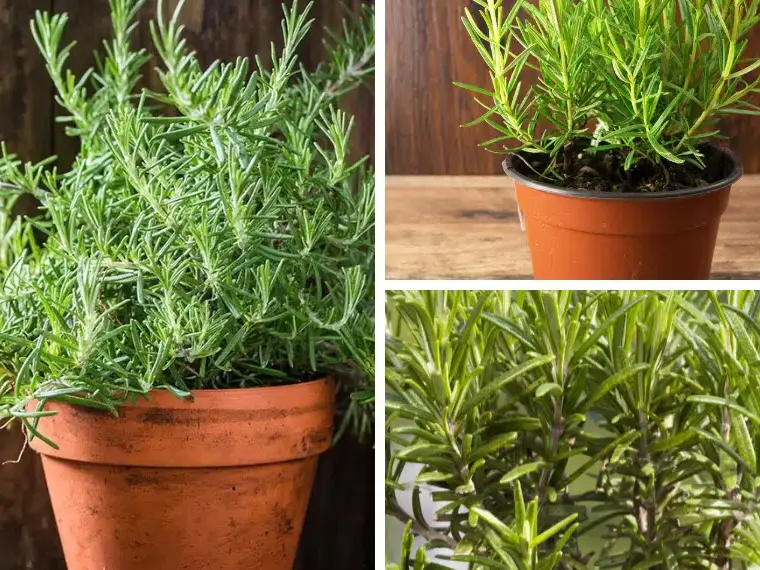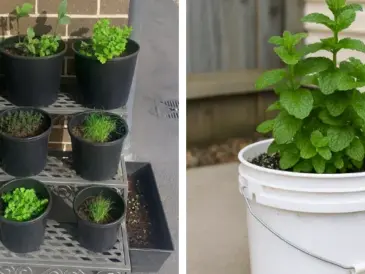There’s something truly magical about a thriving rosemary plant — the way its fragrant stems brush your fingers as you walk by, releasing that unmistakable, piney aroma.
But if you’ve ever grown rosemary, you know it doesn’t always start out lush and full. Many gardeners struggle with leggy, woody, or sparse rosemary plants that seem to grow upward rather than outward.
Understanding Rosemary’s Growth Habit
Before diving into how to make rosemary bushier, it’s important to understand why it grows the way it does.
Rosemary (Rosmarinus officinalis) is a woody evergreen shrub native to the Mediterranean region. In its natural environment, it grows in poor, rocky soil under full sun and dry conditions.
It naturally forms upright or arching stems that become woody at the base over time.
This woody habit means that once stems mature, they stop producing new leaves. The key to a full rosemary plant is encouraging new soft growth from younger stems, which will eventually fill out the plant’s shape.
Without proper care, rosemary tends to grow tall and sparse – all top, no body. But with regular pruning, light management, and careful watering, you can stimulate new shoots and achieve that compact, full form that every gardener dreams of.
1. Start With Healthy, Young Rosemary
The foundation of a bushy rosemary plant begins with its start. Young, vigorous plants are more responsive to pruning and produce more flexible stems for shaping.
Choose the right variety: Compact types like ‘Arp’, ‘Blue Boy’, or ‘Salem’ naturally grow bushier than tall upright varieties like ‘Tuscan Blue’.
Pick plants with multiple stems: Avoid single, spindly rosemary starts. Choose those that already have several branching points at the base – they’ll fill out faster.
Avoid root-bound plants: When buying rosemary in pots, check for circling roots. Crowded roots can stunt growth and limit branching.
Pro tip: If your rosemary is already woody and sparse, don’t worry – you can still rejuvenate it with a bit of strategic pruning and care (explained below).
2. Give It the Right Light Conditions
Rosemary absolutely loves sunlight – it’s the fuel that powers both foliage density and oil production.
Outdoors: Choose a full sun location with at least 6–8 hours of direct light daily. The more sunlight your rosemary receives, the thicker and bushier its growth will be.
Indoors: Place your plant near a south-facing window or under a grow light for 12–14 hours a day. Without enough light, rosemary stretches toward the source, becoming leggy and weak.
Rotate regularly: Turn your plant every week to ensure all sides get even light exposure – this prevents lopsided growth.
Tip: A rosemary plant in partial shade will often survive but never thrive. If your plant looks sparse or pale, insufficient light is usually to blame.
3. Use the Right Soil Mix
Rosemary’s Mediterranean roots mean it prefers light, well-draining soil – not rich, heavy, or constantly moist conditions.
Overly fertile or soggy soil encourages tall, weak growth instead of compact, woody stems.
Ideal soil mix:
- 1 part potting soil
- 1 part coarse sand or perlite
- 1 part compost or pine bark fines
This blend ensures excellent drainage while retaining enough nutrients to support steady growth.
pH preference: Rosemary grows best in slightly alkaline soil (6.5–7.5). You can mix a pinch of wood ash or crushed eggshells into the soil once or twice a year to maintain pH balance.
Pro tip: Avoid heavy clay soils – they suffocate roots and lead to root rot, which stops new shoots from forming.
4. Master the Art of Pruning
If you want your rosemary to grow bushy, pruning is non-negotiable. The way you trim determines how much new growth your plant produces.
How Pruning Works
Every time you trim the tip of a rosemary stem, you trigger two new shoots to grow from the nodes below the cut. The more you prune, the more the plant branches – creating that dense, full structure you’re after.
When to Prune Rosemary
- Spring: The best time for major shaping. Trim back ⅓ of the plant after the last frost.
- Mid-summer: Lightly trim new shoots to encourage branching and maintain shape.
- Fall: Avoid heavy pruning before winter; rosemary needs foliage to protect itself from cold.
How to Prune for Bushier Growth
- Use sharp, clean shears to avoid crushing stems.
- Cut just above a leaf node (where leaves meet the stem).
- Remove long, unbranched stems to balance the shape.
- Focus on younger green growth – never cut deep into old, woody sections, as they rarely regrow.
- Regularly pinch off 1–2 inches of new tips throughout the growing season.
This gentle but consistent pruning habit keeps rosemary compact and encourages constant regrowth.
Pro tip: Every few months, prune one or two of the oldest stems near the base to make room for new shoots from below.
5. Avoid Overwatering
Rosemary thrives on neglect when it comes to watering. Too much water suffocates roots, while too little can dry them out completely – both conditions stunt growth and prevent fullness.
Watering Tips for Bushy Growth
- Let the top 1–2 inches of soil dry before watering again.
- Water deeply, allowing excess to drain out completely.
- Empty saucers after watering – rosemary hates sitting in water.
- In humid climates, water even less frequently.
Signs of overwatering: Yellowing leaves, droopy stems, or blackened roots.
Signs of underwatering: Browning leaf tips and dry, brittle branches.
Remember: Consistent but moderate moisture encourages steady growth without stress.
6. Feed Lightly – Don’t Overfertilize
Too much fertilizer encourages soft, leggy growth with fewer aromatic oils. Instead, aim for slow, balanced nourishment.
Fertilizing tips:
- Use a diluted, balanced fertilizer (10-10-10) once a month in spring and summer.
- Stop feeding in late summer to let growth harden before cooler weather.
- Alternatively, mix in compost or worm castings at the start of the season for a slow nutrient release.
If your rosemary is grown in poor soil, a small amount of fish emulsion or seaweed extract can also promote healthy, dense foliage without overstimulating it.
Pro tip: Excess nitrogen is the enemy of bushiness. It makes stems grow tall and floppy – so when in doubt, feed less.
7. Repot or Refresh Soil Every 2–3 Years
As rosemary grows, its root system becomes dense, and the soil gradually loses structure and nutrients. Repotting or refreshing the top layer of soil helps maintain vigorous growth.
How to Repot for Fuller Growth:
- Choose a pot only 1–2 inches larger than the current one – rosemary likes snug roots.
- Use fresh, fast-draining soil.
- Trim back the top growth by about one-third to balance the root-to-leaf ratio.
- Water lightly and keep it in indirect light for a few days to recover.
Pro tip: If growing outdoors, gently loosen and amend the top 2 inches of soil each spring to renew aeration and nutrients.
8. Encourage Air Circulation and Sunlight
Dense foliage needs airflow to stay healthy. Without it, the center of your rosemary can become sparse or moldy.
- Space plants at least 18–24 inches apart in garden beds.
- Avoid overcrowding rosemary with other herbs.
- Indoors, place it in a bright, breezy window or near a small fan for airflow.
Good circulation reduces fungal risks and keeps growth balanced across the entire plant.
9. Pinch Young Growth Regularly
This small habit makes a big difference. Pinching (using your fingers instead of shears) is a gentle way to encourage branching without over-pruning.
- Once your rosemary has at least 6 inches of new growth, pinch off the top 1 inch.
- Repeat every 3–4 weeks during spring and summer.
- Each pinch redirects energy into side shoots, thickening the overall plant structure.
Bonus: Those pinched sprigs are perfect for cooking or making rosemary-infused oils!
10. Harvest the Right Way
Even how you harvest rosemary can influence its fullness. Avoid stripping the plant bare from one side – it creates uneven, weak growth.
Best harvesting practices:
- Harvest evenly from all sides of the plant.
- Never remove more than one-third of the total foliage at once.
- Choose young, green stems for best flavor and regrowth potential.
Pro tip: Regular harvesting acts like light pruning – the more you snip (responsibly), the bushier your rosemary becomes.
11. Protect from Cold and Frost
Rosemary loves warmth but dislikes extreme cold. Frost damage kills tender tips, causing woody regrowth and sparse branching.
Cold protection tips:
- For potted rosemary, bring indoors before temperatures drop below 35°F (1°C).
- Outdoors, mulch around the base with straw or pine needles to insulate roots.
- Avoid heavy pruning before winter – wait until spring when growth resumes.
Healthy overwintering sets the stage for rapid, bushy regrowth once temperatures rise again.
12. Propagate from Cuttings to Rejuvenate Your Rosemary Patch
If your old rosemary plant becomes too woody, propagation is the best way to start fresh – and fill your garden with multiple bushy plants.
How to propagate:
- Take 4–6 inch cuttings from healthy, non-woody stems.
- Strip the lower leaves and dip the end in rooting hormone (optional).
- Plant in a mix of perlite and peat or moist sand.
- Keep in bright, indirect light and mist regularly.
Within 4–6 weeks, new roots form. Once rooted, transplant into well-draining soil and pinch back tips for branching.
Pro tip: Regularly growing new plants keeps your rosemary supply vigorous and prevents woody decline over time.
Common Mistakes That Prevent Bushy Growth
Even with the best intentions, many gardeners unknowingly stunt their rosemary’s potential. Here’s what to avoid:
- Cutting into old wood – Once stems turn brown and woody, they rarely regrow. Always prune into green growth.
- Overwatering – Rosemary prefers to dry out between waterings. Constant moisture leads to root rot.
- Lack of sunlight – Insufficient light causes tall, thin stems instead of dense branching.
- Overfertilizing – Too much nitrogen results in soft, floppy growth.
- Ignoring pruning – Untrimmed rosemary becomes leggy, woody, and hollow at the center.
Correcting these simple issues can dramatically transform your plant within a single season.
How Long It Takes to See Results
With proper pruning, sunlight, and care, you’ll notice fuller growth within 4–6 weeks.
By the second growing season, your rosemary should be dense, rounded, and aromatic, producing abundant sprigs for both cooking and decoration.
Growing bushy rosemary isn’t complicated – it’s about understanding the plant’s rhythm. A little pruning, proper light, and patience go a long way.




